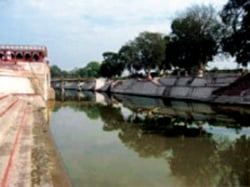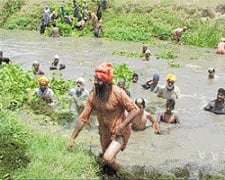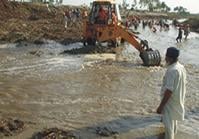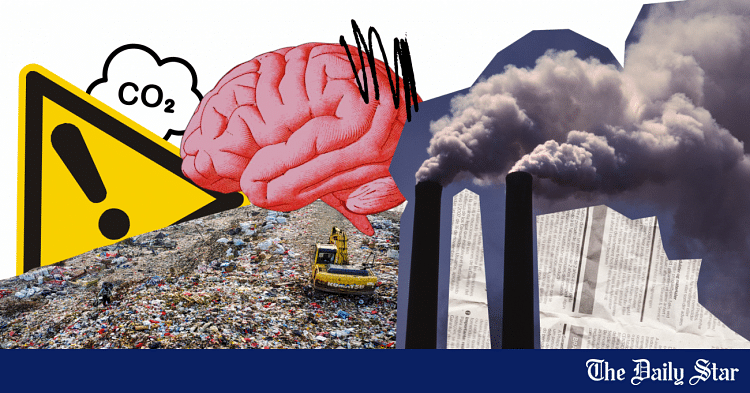Saif
Senior Member
- Jan 24, 2024
- 12,725
- 7,062
- Origin

- Residence

- Axis Group

- Copy to clipboard
- Thread starter
- #217

Adaptation to combat climate change
COP29 in Baku, Azerbaijan, brought the world’s attention once again to strategies to address the climate crisis. While reducing emissions (mitigation) remains essential, it has become increasingly clear that even with significant global efforts, the consequences of climate change are here to...
 www.newagebd.net
www.newagebd.net
Adaptation to combat climate change
Musharraf Tansen 25 November, 2024, 00:00

An aerial photograph shows flooded houses in Feni in August. | Agence France-Presse/Munir uz Zaman
COP29 in Baku, Azerbaijan, brought the world’s attention once again to strategies to address the climate crisis. While reducing emissions (mitigation) remains essential, it has become increasingly clear that even with significant global efforts, the consequences of climate change are here to stay. Rising sea levels, erratic weather patterns, and increasing natural disasters are now a reality, especially for climate-vulnerable nations like Bangladesh. This year’s discussions at COP29 underscore the importance of adaptation as an urgent, essential counterpart to mitigation. Bangladesh stands as a prime example of a country that must invest in adaptation to safeguard its communities, economy, and ecosystems.
Understanding adaptation
ADAPTATION in the context of climate action refers to adjusting our systems, infrastructure, and ways of life to endure and thrive amid climate impacts. While mitigation aims to reduce future risks by lowering greenhouse gases, adaptation accepts that certain consequences are already irreversible and require immediate action. Bangladesh, with its low-lying geography and high population density, is uniquely vulnerable to these impacts. Rising sea levels threaten to inundate vast areas of the country, cyclones regularly devastate coastal communities, and changing rainfall patterns disrupt agriculture. Adaptation, therefore, is not a secondary solution for Bangladesh; it is an existential necessity.
The 2020 Global Adaptation Report suggests that every dollar invested in adaptation could yield a fourfold return in avoided losses, improved productivity, and social and environmental benefits. For Bangladesh, this means that adaptation efforts are not just protective measures but pathways to sustainable development that could lift millions out of poverty and build resilience against future climate impacts.
Urgent need for adaptation in Bangladesh
BANGLADESH’S vulnerability to climate change is no longer theoretical. According to the Intergovernmental Panel on Climate Change, the world could surpass the critical 1.5°C warming threshold within the next decade if the current pace of emissions continues. For Bangladesh, which is ranked among the world’s most climate-vulnerable countries, this reality translates into immediate challenges. Rising sea levels threaten to displace millions, with coastal divisions like Khulna and Barisal already experiencing increased flooding. Riverine communities are at constant risk of erosion, and droughts and erratic monsoon patterns put agricultural productivity in jeopardy.
The agricultural sector, on which a significant portion of Bangladesh’s population depends, is particularly affected by unpredictable weather patterns and extreme temperatures. With over 70 per cent of Bangladeshis relying on agriculture for their livelihoods, adapting farming practices is crucial to ensure food security. Climate-resilient crop varieties, improved irrigation systems, and agroforestry are among the adaptation strategies that could help protect Bangladeshi farmers from these growing threats.
Key adaptation strategies for Bangladesh
Climate-resilient infrastructure: Infrastructure that can withstand climate impacts is urgently needed across Bangladesh, especially in urban areas like Dhaka, Chattogram, and Khulna. Flood defences, storm-resistant homes, and drainage systems are essential in areas prone to flooding and cyclones. Bangladesh has already taken steps to develop flood-resistant infrastructure, but the scale and intensity of climate impacts demand even more robust planning and investment.
Enhanced water management: Bangladesh’s water challenges are multifaceted — coastal regions face saltwater intrusion from rising seas, while northern regions suffer from droughts. Rainwater harvesting, desalination, and improved water storage systems are critical for areas where fresh water is becoming scarce. By strengthening water management practices, Bangladesh can mitigate some of the worst impacts of climate change on water resources.
Resilient agriculture and food security: The adaptation of agriculture is essential for Bangladesh to feed its population in the face of climate change. Drought-tolerant and salt-resistant crop varieties are being introduced, but more support for climate-smart agriculture is necessary to ensure that small-scale farmers can maintain productivity even as conditions worsen. Additionally, initiatives to promote crop diversification and sustainable land management can help farmers reduce their vulnerability to climate-induced shocks.
Ecosystem restoration and protection: Natural ecosystems, including the Sunderbans mangrove forest, serve as crucial buffers against climate impacts such as storm surges and floods. The Sunderbans, shared with India, is a UNESCO World Heritage site and home to unique biodiversity, including the endangered Bengal tiger. Protecting and restoring ecosystems like the Sundarbans can provide significant climate resilience, as these natural barriers absorb floodwaters, prevent erosion, and act as carbon sinks.
Locally-led adaptation initiatives: Locally-led adaptation is essential in a diverse country like Bangladesh, where local knowledge can guide effective climate responses. Bangladesh’s coastal communities, for instance, have long relied on traditional knowledge to predict and respond to changes in weather patterns. By empowering communities to take an active role in climate adaptation — through education, skills training, and local governance — Bangladesh can tailor solutions to the unique challenges faced by different regions.
Financing adaptation
DESPITE the clear need for adaptation, financing remains a significant barrier. While international climate finance has historically prioritised mitigation, adaptation in vulnerable countries like Bangladesh continues to face severe funding gaps. COP29 discussions underscored the need for a fairer distribution of climate finance, with developed countries committing to greater support for adaptation in developing nations. In recent years, Bangladesh has advocated strongly for increased climate finance to support its adaptation efforts, yet the scale of funding remains insufficient given the risks the country faces.
The government of Bangladesh has made significant strides, such as setting up the Bangladesh Climate Change Trust Fund to support adaptation and resilience-building projects. However, private sector involvement is essential to bridge the financing gap. Partnerships with businesses and international organisations can drive investment into adaptation projects, from green bonds to public-private ventures in sustainable infrastructure. Additionally, the insurance sector can offer climate risk insurance tailored to the needs of farmers and small businesses, providing a financial safety net that incentivises adaptive practices.
Adaptation and sustainable development
FOR Bangladesh, adaptation is more than just a response to climate threats; it is an opportunity to pursue sustainable development. Many adaptation strategies align with the United Nations’ Sustainable Development Goals, including those related to poverty alleviation, food security, and clean water access. By investing in adaptation, Bangladesh can build a resilient society capable of withstanding environmental changes while simultaneously fostering economic and social growth.
For instance, green urban planning in cities like Dhaka, which integrates green spaces and sustainable transport, not only mitigates heatwaves and flooding but also reduces pollution, improves public health, and enhances overall quality of life. Adaptation offers co-benefits that go beyond climate resilience, setting the foundation for an inclusive and sustainable future for Bangladesh.
Global solidarity and responsibility
COP29 has reinforced that adaptation is not just a national issue for Bangladesh but a global necessity. Wealthier nations bear a responsibility to support countries like Bangladesh in building adaptive capacity. Investing in climate adaptation is not just the right thing to do but is also the economically smart thing to do. Wealthier nations must uphold their responsibility to support climate-vulnerable countries by delivering on pledges for adaptation finance. Adaptation, beyond merely building resilience, is essential for securing lives, food supplies, and stability amid a rapidly changing climate. Wealthy countries must share technology, mobilise financial resources, and transfer expertise to help vulnerable nations develop climate-resilient infrastructure and strategies. In addition, we should demand more direct funding for local adaptation initiatives, where climate impacts are most severely felt.
Moreover, the private sector, government agencies, NGOs, and local communities must collaborate to scale up adaptation efforts and ensure that no one is left behind. The climate crisis transcends borders; heatwaves, floods, and droughts in one region have global ripple effects on food security, migration, and health. Only by embracing adaptation as a universal priority can the world hope to navigate the climate challenges that lie ahead.
Balanced climate agenda for Bangladesh
THE realities of climate change demand that Bangladesh approach adaptation and mitigation hand in hand. While reducing emissions remains critical, preparing Bangladeshi communities to handle the impacts already underway is equally vital. COP discussions have highlighted that adaptation is not a fallback option but a cornerstone of a comprehensive climate response.
In a world where climate impacts are increasingly immediate, adaptation offers Bangladesh a path towards resilience, stability, and equity. Bangladesh has a unique opportunity to champion adaptation as a key component of climate action — one that protects its people, preserves its natural resources, and paves the way for a sustainable future for generations to come.
Musharraf Tansen is a development analyst and former Bangladesh representative of Malala Fund.
Musharraf Tansen 25 November, 2024, 00:00
An aerial photograph shows flooded houses in Feni in August. | Agence France-Presse/Munir uz Zaman
COP29 in Baku, Azerbaijan, brought the world’s attention once again to strategies to address the climate crisis. While reducing emissions (mitigation) remains essential, it has become increasingly clear that even with significant global efforts, the consequences of climate change are here to stay. Rising sea levels, erratic weather patterns, and increasing natural disasters are now a reality, especially for climate-vulnerable nations like Bangladesh. This year’s discussions at COP29 underscore the importance of adaptation as an urgent, essential counterpart to mitigation. Bangladesh stands as a prime example of a country that must invest in adaptation to safeguard its communities, economy, and ecosystems.
Understanding adaptation
ADAPTATION in the context of climate action refers to adjusting our systems, infrastructure, and ways of life to endure and thrive amid climate impacts. While mitigation aims to reduce future risks by lowering greenhouse gases, adaptation accepts that certain consequences are already irreversible and require immediate action. Bangladesh, with its low-lying geography and high population density, is uniquely vulnerable to these impacts. Rising sea levels threaten to inundate vast areas of the country, cyclones regularly devastate coastal communities, and changing rainfall patterns disrupt agriculture. Adaptation, therefore, is not a secondary solution for Bangladesh; it is an existential necessity.
The 2020 Global Adaptation Report suggests that every dollar invested in adaptation could yield a fourfold return in avoided losses, improved productivity, and social and environmental benefits. For Bangladesh, this means that adaptation efforts are not just protective measures but pathways to sustainable development that could lift millions out of poverty and build resilience against future climate impacts.
Urgent need for adaptation in Bangladesh
BANGLADESH’S vulnerability to climate change is no longer theoretical. According to the Intergovernmental Panel on Climate Change, the world could surpass the critical 1.5°C warming threshold within the next decade if the current pace of emissions continues. For Bangladesh, which is ranked among the world’s most climate-vulnerable countries, this reality translates into immediate challenges. Rising sea levels threaten to displace millions, with coastal divisions like Khulna and Barisal already experiencing increased flooding. Riverine communities are at constant risk of erosion, and droughts and erratic monsoon patterns put agricultural productivity in jeopardy.
The agricultural sector, on which a significant portion of Bangladesh’s population depends, is particularly affected by unpredictable weather patterns and extreme temperatures. With over 70 per cent of Bangladeshis relying on agriculture for their livelihoods, adapting farming practices is crucial to ensure food security. Climate-resilient crop varieties, improved irrigation systems, and agroforestry are among the adaptation strategies that could help protect Bangladeshi farmers from these growing threats.
Key adaptation strategies for Bangladesh
Climate-resilient infrastructure: Infrastructure that can withstand climate impacts is urgently needed across Bangladesh, especially in urban areas like Dhaka, Chattogram, and Khulna. Flood defences, storm-resistant homes, and drainage systems are essential in areas prone to flooding and cyclones. Bangladesh has already taken steps to develop flood-resistant infrastructure, but the scale and intensity of climate impacts demand even more robust planning and investment.
Enhanced water management: Bangladesh’s water challenges are multifaceted — coastal regions face saltwater intrusion from rising seas, while northern regions suffer from droughts. Rainwater harvesting, desalination, and improved water storage systems are critical for areas where fresh water is becoming scarce. By strengthening water management practices, Bangladesh can mitigate some of the worst impacts of climate change on water resources.
Resilient agriculture and food security: The adaptation of agriculture is essential for Bangladesh to feed its population in the face of climate change. Drought-tolerant and salt-resistant crop varieties are being introduced, but more support for climate-smart agriculture is necessary to ensure that small-scale farmers can maintain productivity even as conditions worsen. Additionally, initiatives to promote crop diversification and sustainable land management can help farmers reduce their vulnerability to climate-induced shocks.
Ecosystem restoration and protection: Natural ecosystems, including the Sunderbans mangrove forest, serve as crucial buffers against climate impacts such as storm surges and floods. The Sunderbans, shared with India, is a UNESCO World Heritage site and home to unique biodiversity, including the endangered Bengal tiger. Protecting and restoring ecosystems like the Sundarbans can provide significant climate resilience, as these natural barriers absorb floodwaters, prevent erosion, and act as carbon sinks.
Locally-led adaptation initiatives: Locally-led adaptation is essential in a diverse country like Bangladesh, where local knowledge can guide effective climate responses. Bangladesh’s coastal communities, for instance, have long relied on traditional knowledge to predict and respond to changes in weather patterns. By empowering communities to take an active role in climate adaptation — through education, skills training, and local governance — Bangladesh can tailor solutions to the unique challenges faced by different regions.
Financing adaptation
DESPITE the clear need for adaptation, financing remains a significant barrier. While international climate finance has historically prioritised mitigation, adaptation in vulnerable countries like Bangladesh continues to face severe funding gaps. COP29 discussions underscored the need for a fairer distribution of climate finance, with developed countries committing to greater support for adaptation in developing nations. In recent years, Bangladesh has advocated strongly for increased climate finance to support its adaptation efforts, yet the scale of funding remains insufficient given the risks the country faces.
The government of Bangladesh has made significant strides, such as setting up the Bangladesh Climate Change Trust Fund to support adaptation and resilience-building projects. However, private sector involvement is essential to bridge the financing gap. Partnerships with businesses and international organisations can drive investment into adaptation projects, from green bonds to public-private ventures in sustainable infrastructure. Additionally, the insurance sector can offer climate risk insurance tailored to the needs of farmers and small businesses, providing a financial safety net that incentivises adaptive practices.
Adaptation and sustainable development
FOR Bangladesh, adaptation is more than just a response to climate threats; it is an opportunity to pursue sustainable development. Many adaptation strategies align with the United Nations’ Sustainable Development Goals, including those related to poverty alleviation, food security, and clean water access. By investing in adaptation, Bangladesh can build a resilient society capable of withstanding environmental changes while simultaneously fostering economic and social growth.
For instance, green urban planning in cities like Dhaka, which integrates green spaces and sustainable transport, not only mitigates heatwaves and flooding but also reduces pollution, improves public health, and enhances overall quality of life. Adaptation offers co-benefits that go beyond climate resilience, setting the foundation for an inclusive and sustainable future for Bangladesh.
Global solidarity and responsibility
COP29 has reinforced that adaptation is not just a national issue for Bangladesh but a global necessity. Wealthier nations bear a responsibility to support countries like Bangladesh in building adaptive capacity. Investing in climate adaptation is not just the right thing to do but is also the economically smart thing to do. Wealthier nations must uphold their responsibility to support climate-vulnerable countries by delivering on pledges for adaptation finance. Adaptation, beyond merely building resilience, is essential for securing lives, food supplies, and stability amid a rapidly changing climate. Wealthy countries must share technology, mobilise financial resources, and transfer expertise to help vulnerable nations develop climate-resilient infrastructure and strategies. In addition, we should demand more direct funding for local adaptation initiatives, where climate impacts are most severely felt.
Moreover, the private sector, government agencies, NGOs, and local communities must collaborate to scale up adaptation efforts and ensure that no one is left behind. The climate crisis transcends borders; heatwaves, floods, and droughts in one region have global ripple effects on food security, migration, and health. Only by embracing adaptation as a universal priority can the world hope to navigate the climate challenges that lie ahead.
Balanced climate agenda for Bangladesh
THE realities of climate change demand that Bangladesh approach adaptation and mitigation hand in hand. While reducing emissions remains critical, preparing Bangladeshi communities to handle the impacts already underway is equally vital. COP discussions have highlighted that adaptation is not a fallback option but a cornerstone of a comprehensive climate response.
In a world where climate impacts are increasingly immediate, adaptation offers Bangladesh a path towards resilience, stability, and equity. Bangladesh has a unique opportunity to champion adaptation as a key component of climate action — one that protects its people, preserves its natural resources, and paves the way for a sustainable future for generations to come.
Musharraf Tansen is a development analyst and former Bangladesh representative of Malala Fund.














